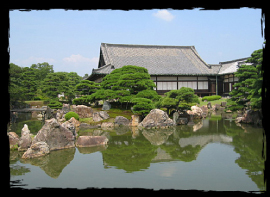 |
 |
A famous garden designed by Kobori Enshu, representative of the Japanese gardening style known as Chisen-kaiyushiki. |
 |
 |
This garden in the Chisen-kaiyushiki style (a style dating back to ancient times with wandering ponds following the natural flow of the land) is representative of the Shoin-zukuri type of garden (residential gardens of the samurai class).
The garden features a pond with a single room constructed on the pond itself. There are also two islands in the pond and four bridges. The graceful rocks, flowering plants and trees create an inner courtyard garden that can be enjoyed in all four seasons. The garden was designed to represent the Chinese tradition of Horaishisenshiso, the mythical Island of Eternal Happiness said to be populated by wizards capable of performing miracles. The garden is also known as Hachijin-no-niwa (the garden of the eight natural elements [in the Chinese tradition]), representing the Heavens, Earth, Wind, Clouds, Dragons,Tigers, Birds and Snakes).
The garden was reconstructed in 1626 in preparation for a visit by the Emperor Gomizuno-o by Kobori Enshu (1579 - 1647), a famous tea ceremony expert, architect and gardener who held the post of Fushinbugyo (the government official in charge of construction). The garden was redesigned so that it was visible from the Shogun's seat in the Ohiroma and Kuro-shoin rooms and, of course, from the Emperor's seat. The garden was specified as a place of scenic beauty in 1939, and again as a national special place of scenic beauty in 1953. |
| |
|
|
 |
 |
A national special place of scenic beauty
- the Ninomaru Garden |
|
| |
|

